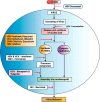Recent Updates on Viral Oncogenesis: Available Preventive and Therapeutic Entities
- PMID: 37486263
- PMCID: PMC10410670
- DOI: 10.1021/acs.molpharmaceut.2c01080
Recent Updates on Viral Oncogenesis: Available Preventive and Therapeutic Entities
Abstract
Human viral oncogenesis is a complex phenomenon and a major contributor to the global cancer burden. Several recent findings revealed cellular and molecular pathways that promote the development and initiation of malignancy when viruses cause an infection. Even, antiviral treatment has become an approach to eliminate the viral infections and prevent the activation of oncogenesis. Therefore, for a better understanding, the molecular pathogenesis of various oncogenic viruses like, hepatitis virus, human immunodeficiency viral (HIV), human papillomavirus (HPV), herpes simplex virus (HSV), and Epstein-Barr virus (EBV), could be explored, especially, to expand many potent antivirals that may escalate the apoptosis of infected malignant cells while sparing normal and healthy ones. Moreover, contemporary therapies, such as engineered antibodies antiviral agents targeting signaling pathways and cell biomarkers, could inhibit viral oncogenesis. This review elaborates the recent advancements in both natural and synthetic antivirals to control viral oncogenesis. The study also highlights the challenges and future perspectives of using antivirals in viral oncogenesis.
Keywords: Antiviral Agents; Malignancy; Oncoviruses; Therapeutics; Viral Oncogenesis.
Conflict of interest statement
The authors declare no competing financial interest.
Figures




Similar articles
-
The Role of Viruses in Carcinogenesis and Molecular Targeting: From Infection to Being a Component of the Tumor Microenvironment.OMICS. 2021 Jun;25(6):358-371. doi: 10.1089/omi.2021.0052. Epub 2021 May 25. OMICS. 2021. PMID: 34037476 Review.
-
Drug targets in herpes simplex and Epstein Barr Virus infections.Infect Disord Drug Targets. 2009 Apr;9(2):117-25. doi: 10.2174/187152609787847703. Infect Disord Drug Targets. 2009. PMID: 19275700 Review.
-
The Fight against the Carcinogenic Epstein-Barr Virus: Gut Microbiota, Natural Medicines, and Beyond.Int J Mol Sci. 2023 Jan 15;24(2):1716. doi: 10.3390/ijms24021716. Int J Mol Sci. 2023. PMID: 36675232 Free PMC article. Review.
-
Deciphering the roles of myeloid derived suppressor cells in viral oncogenesis.Front Immunol. 2023 Mar 23;14:1161848. doi: 10.3389/fimmu.2023.1161848. eCollection 2023. Front Immunol. 2023. PMID: 37033972 Free PMC article. Review.
-
Decoding the molecular complexity of viruses in human cancer: insights into host cell infection, oncogenesis, and therapeutic prospects.Crit Rev Microbiol. 2025 Mar 6:1-24. doi: 10.1080/1040841X.2025.2461045. Online ahead of print. Crit Rev Microbiol. 2025. PMID: 40051042 Review.
Cited by
-
Raman Multi-Omic Snapshot and Statistical Validation of Structural Differences between Herpes Simplex Type I and Epstein-Barr Viruses.Int J Mol Sci. 2023 Oct 25;24(21):15567. doi: 10.3390/ijms242115567. Int J Mol Sci. 2023. PMID: 37958551 Free PMC article.
-
Estimates of the global burden of non-Hodgkin lymphoma attributable to HIV: a population attributable modeling study.EClinicalMedicine. 2023 Dec 16;67:102370. doi: 10.1016/j.eclinm.2023.102370. eCollection 2024 Jan. EClinicalMedicine. 2023. PMID: 38130708 Free PMC article.
-
Harnessing Nanohybridized Niclosamide for Precision Mpox Therapeutics.Adv Healthc Mater. 2025 May;14(14):e2404818. doi: 10.1002/adhm.202404818. Epub 2025 Feb 23. Adv Healthc Mater. 2025. PMID: 39988865 Free PMC article. Review.
-
Oncogenic viruses rewire the epigenome in human cancer.Front Cell Infect Microbiol. 2025 Jun 10;15:1617198. doi: 10.3389/fcimb.2025.1617198. eCollection 2025. Front Cell Infect Microbiol. 2025. PMID: 40557320 Free PMC article. Review.
-
Applications of cell therapy in the treatment of virus-associated cancers.Nat Rev Clin Oncol. 2024 Oct;21(10):709-724. doi: 10.1038/s41571-024-00930-x. Epub 2024 Aug 19. Nat Rev Clin Oncol. 2024. PMID: 39160243 Review.
References
Publication types
MeSH terms
Substances
LinkOut - more resources
Full Text Sources
Medical

